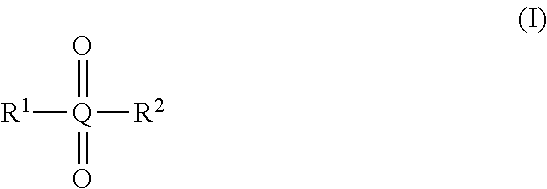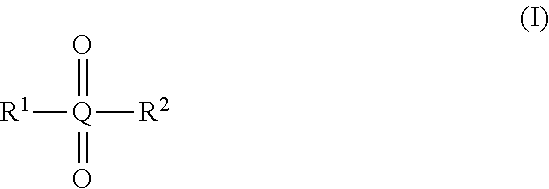Antimicrobial compositions
a technology of compositions and antimicrobials, applied in the field of antimicrobial compositions, can solve the problems of biofilms threatening human health, difficult treatment of these infections, and affecting healing, and achieve the effect of inhibiting the formation of biofilms on the skin
- Summary
- Abstract
- Description
- Claims
- Application Information
AI Technical Summary
Benefits of technology
Problems solved by technology
Method used
Image
Examples
example 1
Reduction of Plaque Development after Single Brushing
[0127]Toothpaste was prepared comprising EDTA (tetrasodium salt) and MSM, which were purchased from Sigma. Control was a leading “anti-plaque” toothpaste available in the market.
[0128]
TreatmentReduction in Plaque IndexControl toothpaste1.115.4% MSM / 2.6% EDTA tooth gel2.295.0% MSM / 2.0% sodium citrate gel1.875.0% MSM / 2.0% sodium phytate gel1.73
[0129]The MSM / EDTA toothpaste showed 106% greater reduction in plaque. This showed a high degree of statistical significance.
example 2
Reduction of Plaque Development after Repeated Brushings
[0130]Toothpaste was prepared comprising EDTA (tetrasodium salt) and MSM, which were purchased from Sigma. Control was a leading “anti-plaque” toothpaste available in the market. Loe Sillness dental plaque index was measured on subjects after 2 weeks of twice daily brushing, after an initial prophylaxis.
[0131]
TreatmentPlaque IndexControl toothpaste1.895.4% MSM / 2.6% EDTA tooth gel0.135.0% MSM / 2.0% sodium citrate gel0.955.0% MSM / 2.0% sodium phytate gel1.18
[0132]The MSM+chelator results compared to control showed extremely high statistical significance.
example 3
96-Well Microtiter Plate Biofilm Cell Detachment Assay
[0133]The wells of a 96-well microtiter plate (Falcon no. 353072) were filled with 100 μl of medium containing 102 to 104 CFU of bacteria and incubated at 37° C. in 10% CO2 for 20 hours. Ten μl of enzyme solution [1 mg / ml in phosphate buffered saline (PBS)], or 10 μl of PBS in the case of controls, was added to each well and the plates were incubated for an additional 6 hours. The wells were washed extensively under running tap water and the bacteria remaining attached to the surface were stained with crystal violet, rewashed, and destained with ethanol in accordance with procedures described by Kachlany et al. Mol. Microbiol. 2001 40:542-554). The optical density (O.D.) of the ethanol-dye solution was measured in a BioRad Benchmark microtiter plate reader set to 590 nm.
Example 4
Effect of the Formulation on Underarm Polymicrobial Biofilms that Lead to Underarm Body Odor
[0134]A relatively benign polymicrobial infection called Tric...
PUM
| Property | Measurement | Unit |
|---|---|---|
| melting point | aaaaa | aaaaa |
| time | aaaaa | aaaaa |
| time | aaaaa | aaaaa |
Abstract
Description
Claims
Application Information
 Login to View More
Login to View More - R&D
- Intellectual Property
- Life Sciences
- Materials
- Tech Scout
- Unparalleled Data Quality
- Higher Quality Content
- 60% Fewer Hallucinations
Browse by: Latest US Patents, China's latest patents, Technical Efficacy Thesaurus, Application Domain, Technology Topic, Popular Technical Reports.
© 2025 PatSnap. All rights reserved.Legal|Privacy policy|Modern Slavery Act Transparency Statement|Sitemap|About US| Contact US: help@patsnap.com



